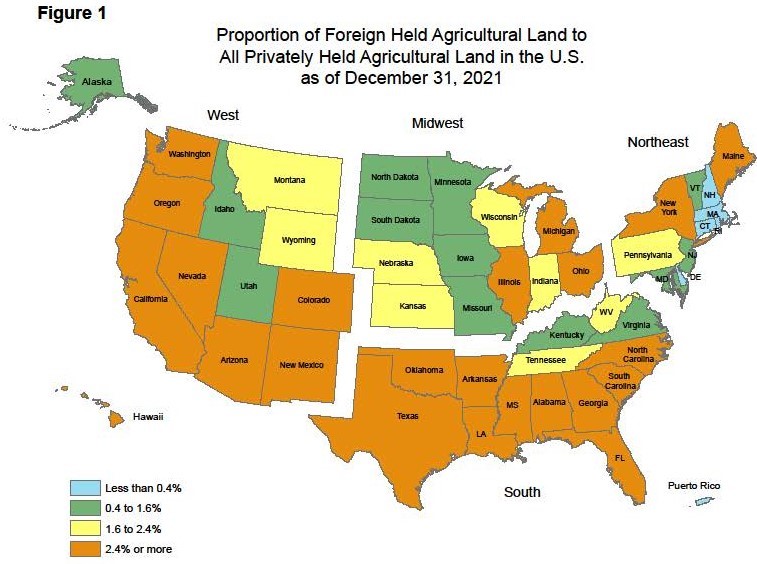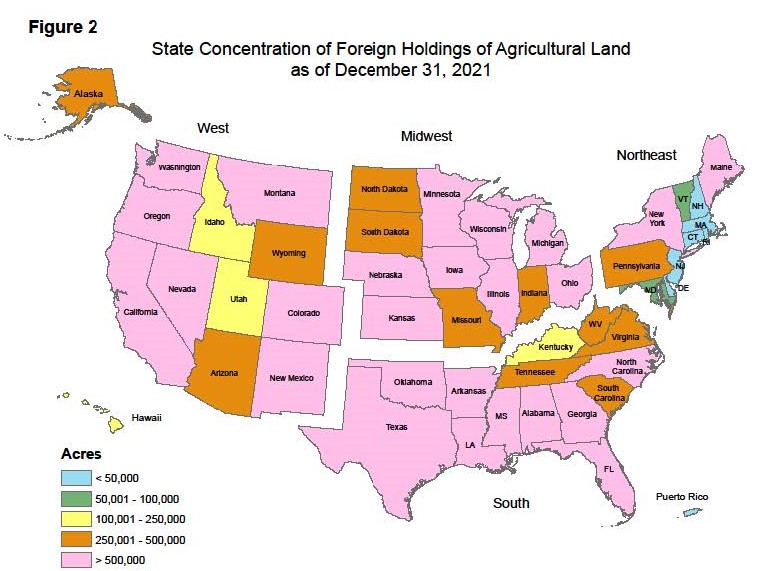By Kirk D. Weih, ALC
Foreign investment in U.S. farmland continues to be a sensitive topic for many Americans, with concerns ranging from food security to national security. The global landscape has seen various countries and foreign individuals channeling their resources into American agriculture, raising questions about who is investing in U.S. farmland and the implications of such investments. The impact of public policy, the balance of trade, and the potential consequences for American agriculture have prompted policymakers to address these issues. Senator Joni Ernst (R-IA), in her role as a member of the Senate Committee on Agriculture, Nutrition and Forestry, is working closely with the U.S. Department of Agriculture (USDA). This agency is charged with monitoring foreign investment in farmland under the Agricultural Foreign Investment Disclosure Act (AFIDA) of 1978. Highlighting concerns surrounding Chinese investment, she has announced a bipartisan proposal aimed at overhauling the monitoring of foreign ownership of farmland across the country.
Interest in foreign investment in U.S. farmland has been in the news recently, largely due to concerns about possible purchases by China. Most foreign agricultural land holdings are from entities in Canada, western Europe, Mexico, Japan, and a few other countries. As of December 31, 2021, the China share is less than 1 percent, which is relatively small compared to many other countries, but politically very sensitive.
The 117th Congress introduced a range of proposals to restrict foreign investment and ownership in the U.S. food and agriculture sector and enacted certain new reporting requirements for the U.S. Department of Agriculture (USDA) related to disclosure of foreign ownership of U.S. agricultural lands. The 118th Congress, which started January 3, 2023, might consider additional modifications during the upcoming farm bill debate.
Background
AFIDA requires all “foreign persons” (as defined by the regulation) who acquire or transfer any interest in U.S. agricultural land to file a report of such holdings with the Secretary of Agriculture. Such persons are required to report such transactions within 90 days of the date of acquisition or transfer. In addition, any foreign person who holds land that subsequently becomes or ceases to be agricultural land, or any
person who holds agricultural land and subsequently becomes or ceases to be a foreign person, must also file a report within 90 days of such change. AFIDA tracks foreign ownership to the third tier.
“Agricultural land” as defined by AFIDA includes not just crop and pasture land, but also any land in the United States used for forestry production. As further clarified in the regulation, land used for forestry production means land exceeding 10 acres in size in which 10 percent is stocked by trees of any size including land that formerly had such tree cover and will be naturally or artificially regenerated. The regulation further defines agricultural land as all land used for farming, ranching, or timber production if the land is more than 10 acres in size in the aggregate. Land which is currently idle, but last used within the past 5 years for farming, ranching, or timber production, must be reported. Land totaling 10 acres or less in the aggregate, and which produce annual gross receipts in excess of $1,000 from the sale of farm, ranch, forestry or timber products, must also be reported.
Current Situation
AFIDA filings indicate that foreign investors held an interest in approximately 40 million acres of U.S. agricultural land (forest land and farm land) as of December 31, 2021, the most recent data available. This is an increase of over 2.4 million acres from the December 31, 2020 report and represents 3.1 percent of all privately held agricultural land in the United States. Forest land accounted for 47 percent of all reported foreign-held agricultural acreage, cropland for 29 percent, pasture and other agricultural land for 22 percent, and non-agricultural land (homesteads, access roads) for 2 percent. Foreign holdings of U.S. agricultural land increased modestly from 2009 through 2015, increasing an average of 2.2 million acres annually.

Foreign persons have reported acreage holdings in all 50 States and Puerto Rico. In all states other than Maine, privately held foreign agricultural land (on a percentage basis) is a small share of all privately held agricultural land. Maine acreage aside, foreign investment in U.S. agricultural land is concentrated in the South and West.
Texas has the largest amount of foreign-held U.S. agricultural land with approximately 5.3 million acres. Maine has the second largest amount of foreign-held agricultural acres, with just over 3.6 million. Colorado has the third largest amount of foreign-held agricultural land with approximately 1.9 million acres.
In terms of percentages, roughly 20.1 percent of Maine’s privately held agricultural land is held by foreign investors; this is approximately 9 percent of the reported foreign-held agricultural land in the United States. Hawaii has the second largest percentage of foreign-held U.S. agricultural land, which is 9.2 percent of the privately held agricultural land in the state, and less than 1 percent of the reported foreign-held agricultural land in the United States. The majority of foreign-held agricultural land in Maine consists of forest land while the bulk of Hawaii’s foreign held agricultural land is pasture land. Washington (7.2 percent), Alabama (6.3 percent), and Florida (6.3 percent) have the next largest percentages of reported foreign-held agricultural land within each of those states.

Canadian Investors are the Largest Foreign Owners
Canadian investors own the largest amount of reported foreign-held agricultural and non-agricultural land, with 31 percent, or 12.8 million acres. Foreign persons from an additional four countries, the Netherlands with 12 percent, Italy with 7 percent, the United Kingdom with 6 percent, and Germany with 6 percent, collectively held 12.4 million acres or 31 percent of the foreign-held acres in the United States. The remaining 15.6 million acres, or 38 percent of all reported foreign-held agricultural and non-agricultural acres, are held by various other countries. For example, China held 383,935 acres, which is slightly less than 1 percent of foreign-held acres.
State Restrictions on Foreign Ownership Vary
Some states and localities have instituted restrictions on foreign ownership of farmland. An overview of state laws by researchers at the University of Arkansas’s National Agricultural Law Center shows that no U.S. state has instituted an absolute prohibition on foreign ownership. However, some states limit or have proposed to prohibit certain foreign persons and entities from acquiring or owning an interest in agricultural land within their state, and several states have disclosure requirements.
There is no single uniform approach under state laws to addressing foreign ownership. Some general categories include restrictions on the amount of land that can be owned or the duration of ownership; distinctions involving private versus public land or how agricultural land is defined; distinctions involving resident/nonresident aliens; inheritance considerations involving land ownership; and restrictions on ownership by foreign corporations (e.g., corporate farming laws or requirements corporations are subject to in order to obtain license or register).
To learn more, contact Mary Estep, USDA, AFIDA Program Manager at mary.estep@usda.gov.
Sources:
Foreign Holdings of U.S. Agricultural Land Through December 31, 2021, AFIDA annual report, USDA, Farm Service Agency
AFIDA regulation
Foreign Ownership and Holdings of U.S. Agricultural Land, Congressional Research Service
Foreign Ownership of Agricultural Land: FAQs & Resource Library, The National Agricultural Law Center
 Kirk has provided farm management and real estate sales/acquisitions services to clients since 1979 in Iowa. He served RLI as National Co-Chair of Government Relations and Iowa Chapter President.
Kirk has provided farm management and real estate sales/acquisitions services to clients since 1979 in Iowa. He served RLI as National Co-Chair of Government Relations and Iowa Chapter President.